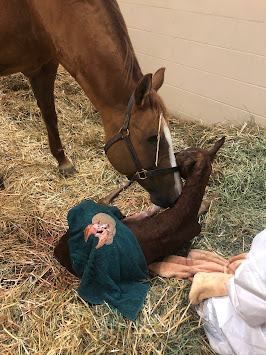Time waits for no foal.
Start your engines.
For the foal, a successful transition to extrauterine life may be complicated by events both before and during parturition. Some of these can be predicted, or at least you are on notice (see I don’t think it’s right…). Once delivered, the neonate must rapidly develop altered cardiovascular, respiratory and gastrointestinal function; stand; suckle; achieve coordinated limb movements, and then prepare for a myriad of infectious challenges. Although born immune deficient through a lack of pre-suckle antibodies, the foal can successfully mount a response to many infectious challenges once sufficient colostrum has been ingested and immunoglobulins absorbed. Should this fail, common signs include depression, generalized weakness, weak or absent suckle reflex, fever or hypothermia, signs of infection, and abnormal neurological function. Not really that specific for any one condition as we could ascribe these events to almost every sick foal regardless of the cause.
The first
indication things are not going right, and these warning signs are on the way,
is a foal who doesn’t hit their early transition to extrauterine life marks.
Times of importance
to the neonatal foal1
Sternal Recumbency:
the foal should right itself and be able to remain sternal within minutes of
birth. Attempts to stand may soon
follow.
Standing: within
60 minutes (range of 15-165 minutes). Compromised neonates tend to remain
recumbent longer, further exposing themselves to pathogens. If left alone, the
umbilical cord detaches when either the foal stands and moves from the mare, or
the mare rises. Once ambulatory the foal, although curious of its environment,
should develop a strong affinity for the mare.
Suckle reflex:
usually develops within 20 minutes of birth, although may be much s
ooner. Some foals being suckling the air within
minutes of birth.
Suckling: the foal
should suckle the mare within 2 hours (range 35 minutes to 7 hours). Foals know
how important colostrum is. So should we. Make sure the mare has a good quantity
of good quality (see Colostrum. It’s what’s for dinner).
Urination: first
urination occurs at 6 hours for colts, 10 hours for fillies. This may appear
concentrated due to a transition from in utero renal function. If the foal
is drinking well this will rapidly dilute then increase markedly in volume and
frequency.
Urine production: approximately
6 mL/kg/hr. The average 50kg foal in
health produces over 7L of urine daily. That is the result of foals drinking
for nutrition and not fluid balance.
Mare’s milk is relatively dilute. Decreases may result from decreased
fluid intake, increased losses, or compromises in renal function. Bladder rupture and uroperitoneum are
possible in the compromised neonate, or one which sustained trauma during
parturition.
Defecation: foals
display abdominal straining within the first few hours after of birth, often
sooner, and pass meconium completely within 24 hours. Colostrum intake stimulates GI motility. Any interference with GI motility will
prolong passage of meconium increasing the likelihood of impaction.
So much to do. So little time. The above goalposts are not
absolute: some foals are on the Dean’s list, some are C students, but that’s still
a pass. While signs of impending trouble may be subtle the foals that start going
forward tend to keep doing so. Beware the stragglers.
1. Koterba A.
Physical examination. In: Koterba A, Drummond W, Kosch P, editors. Equine
Clinical Neonatology. 1 ed. Philadelphia: Lea and Febiger; 1990. p. 71-83.

Comments
Post a Comment